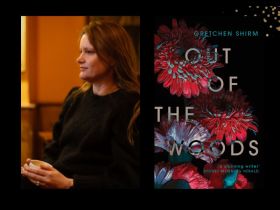Put simply, philanthropy in Australia is growing. CEO of Philanthropy Australia, Louise Walsh, opened Monday night’s SAMAG seminar with some recent statistics:
- Private Giving – and we are talking about donations from $20 to millions of dollars, said Walsh – has remained flat since the GFC (Global Financial Crisis), but the average annual growth is 8.8%. That means the amount being given per donor is growing and that’s the good news; the not-so-good news is the decline in the proportion of taxpayers donating.
- The level of volatility (within giving) has increased in the last decade because of the GFC.
- The great news is the number of public million-dollar-plus donations, what I am calling mega gifts, continue to rise.
- Women are better donors than men.
- Workplace Giving has not been as effective as it should be. Walsh said that when Art Support Australia started it in 2003 the prediction was that it would seriously take off in Australia, but it is only attracting on average 4.5% of employees from the companies offering it (to participate). Walsh added that while in companies such as SEEK and JB HiFi the participation rate is about 54%, arts and culture more generally gets very little of the Workplace Giving pie.
- The standout success story that affects the arts is Private Ancillary Funds (PAFs), which is the most popular vehicle for wealthy individual families through their own charitable foundations. 29% of what PAFs give goes to welfare and 13% to arts and culture, a much higher proportion than across the giving sector.
So what do these statistics and trends mean for you as organisations when it comes to asking for money? And how can we, the arts industry, help sustain and grow the social culture of giving in Australia?
These and other questions were discussed by SAMAG’s expert panel including Hamish Balnaves, GM & Trustree of The Balnaves Foundation; Jessica Block, Deputy General Manager of Australian Chamber Orchestra; and Eliza Sarlos, Artistic Director of Underbelly Arts.
While the panelists came from a diverse perspective the message remained the same: we need to ask more and we need to be clear and direct in that ask.
The challenge of asking:
Walsh relayed an example during her time as director at Art Support Australia, where a group of CEOs of Australian performing arts companies took a study to New York (2012). The incoming Director of the New York Philharmonic Orchestra – who had previously been with the Melbourne Symphony Orchestra – said to his former colleagues that while they imagined we ‘have a problem with the culture of giving in Australia, it is not as bad as you think. The real problem is that you don’t ask enough and you are not good at the ask itself.’
Coming from the other side of the table, Balnaves reiterated: ‘Non-profits are not good at asking. I notice a difference with the larger organisations that employ professional fund-raisers that get to the point. Be direct. Fundraising is sales. Keeping it simple is really important, and presenting it well – what the project is and why it is important.’
‘You both know what you are there for,’ added Sarlos.
Block, who has had a successful career at asking, offered the advice: ‘It is about knowing who you are asking, and for what.’ And, when you ask a potential donor for a specific dollar figure then you need to ‘sit back and say nothing and let silence do the work.’
Being prepared was key to each piece of advice – research, presentation, directness.
Another ‘door opener’ was for your organisation to be eligible for DGR (deductible gift recipient) status. Walsh explained: ‘You really need DGR status if your ask is more than $500 or above.’
While a lot of private ancillary funds technically and legally require for a gift recipient to have DGR, more generally it is considered to give a sense of credibility and trust.
Walsh added that is can take up to nine to 12 months to get it and can be frustrating, but organisations can, for example, use Creative Partnership Australia’s Australian Cultural Fund to auspice them while going through that process.
Walsh led the panel in unpacking some of the trends and models within philanthropy – what was being picked up in Australia and where potential growth areas lie.
Are Giving Circles right for you?
Walsh believes that Giving Circles and Crowdfunding remain the two untapped areas in Australia. Giving Circles are groups of individuals that consolidate or pool their gifts to have more impact. Walsh cited the most high-profile example in Australia as Impact100WA, where 100 donors each give $1,000 to make one $100,000 grant that is transformative.
Walsh said they are ‘a great way of getting more people engaged in philanthrophy.’
Block shared the ACO’s success using this model for their project The Reef, where 30-plus donors gave between $1-$5,000 under the banner of the Creative Music Fund.
She said: ‘It’s a great example of a bunch of visionary individuals who don’t have a huge fortune but it gives you the critical mass to create something important. It is affordable, effective giving.’
They have gone on this year to collaborate with the performing arts company Bangarra Dance Theatre.
Block added: ‘People actually want to get their hands dirty in some way. They don’t just want to give money anymore; they want to learn stuff and be part of it, and if you can offer that in some way then you are going to create a Giving Circle that is really special.’
Walsh said that there is a lot more potential in this sector of philanthropy than we imagine, citing the book club as a perfect example of how collective interests could step up to bringing out an international author, for example.
Is matched funding the latest trend?
While many of us are plagued with crowdfunding ‘opportunities’ on a daily basis, it remains an effective way and is still largely untapped, said Walsh. One area where it has the potential of growing is through matched funding.
‘In the United States it is pretty common to see crowdfunding campaigns matched by a foundation, so that you have low-end donors meeting the high-end,’ said Walsh. ‘It is a great message to those people that every dollar you give is $2.’
The challenge is getting your voice heard and setting modest targets, said self-confessed compulsive crowdfunder Sarlos, who has run several successful campaigns for Underbelly Arts, including one such campaign that was matched by the Kier Foundation.
Walsh noted that, sadly, this particular partnership was not picked up by the media and drew out a point made by Balnaves that media traction can build awareness, and in turn normalize giving.
While crowdfunding is one example, there are some really creative ways you can approach matched funding, whether it be a case of bidding it up the dollar like an auction or putting conditions on the match – such as “’ll give you x if you can get government funding to match it” – Walsh believes that there is great scope in driving the growth of philanthropy through matching.
What is Impact Investing?
The least familiar trend in philanthropy is Impact Investing, also referred to as social investment or social finance, other ways to invest rather than just grants and donations. Typically they might be loans, so there is a return as well as a social return.
The ACO is perhaps the only arts company in Australia that has succeeded in this area and, indeed, has globally led the way with its Instrument Fund.
The Fund’s first acquisition was Australia’s only Stradivarius violin, secured in 2011 for US$1.75 million, and revalued in May 2014 at US$2.75 million. The Fund’s latest acquisition is a 1714 violin made by Joseph Guarneri filius Andreae and purchased for US$1.35 million by the ACO for the ACO Instrument Fund. The violin was revalued in May 2014 at US$1.6 million.
‘It’s not just a donation dressed up as an investment,’ said Block. ‘The idea is that to achieve long-term capital gain, but that there is no regular income stream – it is relatively illiquid.’
The fund was launched three years ago, after years of planning, a pool of lawyers and a visionary board. The ACO seeded the funds which were put into the fund in exchange for units that are then sold down. ‘We could have just done a GC but we wanted people to feel they were really getting something back,’ said Block.
When you have the right product it is a really interesting edge of philanthropy, said Walsh.
And the challenges?
Like the adage ‘you need to spend money to make money’, the panel said it was vital to invest in people – staff – when you are asking for money and servicing those relationships.
It is also immensely important that your board is opening doors for you. You need to get them on as founding donors in your projects then they are selling that belief.
Walsh said that Philanthropy Australia introduced a young donor program last February called New Generation of Giving for people between 20 and 40. It has grown to 200 members.
However, Walsh raised the concern that among this group, ‘the strongest and most popular cause area is international giving, giving to developing countries. The arts is coming in at number six on list, where for their parents who have Private Ancilliary Funds arts and culture is the second highest category. We are seeing a generational shift in the focus areas of giving.’
What will that mean to the sector in the future?
Block said that through their exploring of a young patrons program at ACO they realised they want different things. ‘They don’t necessarily want to go to a two-hour concert; they want to come and hear half an hour, maybe hear it in a home or learn something. You need to engage them in your plans – talk to them.’
Sarlos said that about 80% of Underbellly Arts supporters through crowdfunding are under 40 drawing on their peers. ‘Whether it is $50 or $5,000 donation you want to teach people about giving at the level they can give, and then hopefully grow them.’
Balnaves said that all these things go towards normalising the culture of giving.
‘Wanting to see our grants get (media) coverage is twofold: we are thinking of the organisations we are supporting and by getting them out there raises their profile, but can also lead to more dollars coming by communicating the need and importance of project. Second is that we believe philanthropy needs to be more normalized in our culture. If people are reading about it and it’s in front of them then it starts to become normal practice,’ said Balnaves.
It was the perfect conclusion to looking forward.
For more, consider attending the 2014 Philanthropy Australia conference in Melbourne on 2 September; or our own ArtsHub Conference on 31 October, where Anna Draffin of Philanthropy Australia will deliver the keynote address Make philanthropy work for you.
Creative Partnerships takes its message on the road with its national roadshow on its funding programs. For dates visit their site.
The next SAMAG seminar will be held in Sydney on the topic, New Media: Where to from here? To attend on Monday, 29 September visit SAMAG www.samag.org





